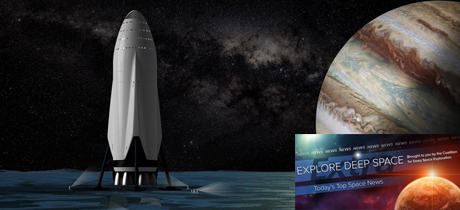In Today’s Deep Space Extra… This year’s International Astronautical Conference, hosted by Australia, wrapped up Friday following a week of global proposals for future exploration of the moon and Mars. Lockheed Martin unveiled a reusable lander/ascent vehicle that could transport astronauts between an orbiting Mars Base Camp and the Martian surface.
Human Space Exploration
Lockheed Martin unveils fully reusable crewed Martian lander
Coalition Member in the News
CNBC (9/28): What might come after NASA’s proposed Deep Space Gateway, a human lunar orbiting space station? It could be Lockheed Martin’s proposed Mars Base Camp and reusable single staged Mars crew lander, which could be adapted for the lunar surface as well. At the surface of the red planet, the shuttle-like lander could house a crew of four for up to two weeks as part of the company’s Mars Base Camp concept. Assembled in lunar orbit, the Mars base camp would trek to Mars orbit to support surface operations. During one long Mars voyage, the lander could touchdown three times using aerobraking technologies that date back to Lockheed Martin’s SR-71 spy plane.
Lockheed Martin trumps SpaceX Mars plans as Elon Musk cancels press conference
Coalition Member in the News
Sydney Morning Herald (9/29): SpaceX’s billionaire founder Elon Musk was beaten to the punch on Friday by U.S. Defense contractor Lockheed Martin, which revealed new details of its ‘Mars Base Camp’ concept at the International Astronautical Congress in Adelaide, including how it aligns with NASA’s lunar Deep Space Gateway and a Mars surface lander.
Elon Musk revises Mars plan, hopes for boots on ground in 2024
CBS via Spaceflightnow.com (9/29): SpaceX founder Elon Musk’s revised strategy for a reusable interplanetary transport would support a human landing on the Martian surface by 2024, he tells the International Astronautical Conference in Adelaide, Australia on Friday.
Space Science
NASA’s James Webb Space Telescope launch delayed to 2019
Popular Mechanics (9/28): NASA is delaying the launch of the James Webb Space Telescope, the designated successor to the Hubble Space Telescope, from October 2018 until between March and June of 2019. More time for final assembly and testing is required. The observatory is soon to complete a demanding thermal vacuum test of the large primary mirror and instrument suite at NASA’s Johnson Space Center and will move on to Northrop Grumman in Redondo Beach, California. There it will undergo final assembly and testing before launching from French Guiana on an Ariane 5 rocket.
Rosetta team finds new, final image hiding in the data
Universe Today (9/28): An unanticipated rocky image has been found in the final transmission from the European Space Agency’s Rosetta spacecraft as it landed on Comet 67P/Churyumov Gerasimenko on September 30, 2016.
Oldest known life on Earth found in 3.95-billion-year-old rocks in Labrador
Seeker (9/28): Possible remnants of microbial life have been found in 3.95 billion year old rocks from northern Labrador in northeastern Canada, according to a Japanese researcher. That’s about 200 million years older than previous evidence for life on Earth. The latest research was reported in the journal Nature.
Other News
Moon village the first stop to Mars: ESA
AFP of Paris, via Phys.org (9/28): The European Space Agency believes a sustained presence on the lunar surface is the next step in the preparations for the exploration of Mars, an agency official told the AFP news service during an interview at the International Astronautical Conference in Adelaide, Australia. A European initiated international Moon Village at the lunar South Pole was proposed by ESA’s director general in 2015.
Ex-space shuttle commander Pamela Melroy moving to Adelaide to join Nova Systems
News.com.au (9/28): Former NASA astronaut Pam Melroy, a shuttle commander, is moving to Australia to help her new homeland launch a commercial space industry.
Airbus to challenge SSL, Orbital ATK with new space tug business
Space News (9/28): Europe’s Airbus and Defense plans to compete in the commercial satellite servicing business with Orbital ATK and Space Systems Loral. Airbus did not indicate a launch date.
ILS declares mission success after Proton launch of AsiaSat 9
Spaceflightnow.com (9/29): A Russian Proton rocket soared from the Baikonur Cosmodrome in Kazakhstan on Thursday with an AsiaSat communications satellite build by California’s Space Systems Loral to serve markets in Indonesia and the Asia Pacific.
Hey citizen scientists! Help NASA analyze images taken from the Space Station
Universe Today (9/28): NASA has joined with the Astronomical Society of the Pacific in calling for volunteers to participate in Image Detective, a project to identify features in photos of the Earth taken by astronauts assigned to the International Space Station.

